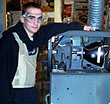|
|
This topic comprises 4 pages: 1 2 3 4
|
|
Author
|
Topic: Projection: Platter v. Changeover - Opinion Poll
|
Joe Beres
Jedi Master Film Handler

Posts: 606
From: Minneapolis, MN, USA
Registered: Nov 2000
|
 posted 10-23-2001 04:32 PM
posted 10-23-2001 04:32 PM




I was talking to a projectionist that worked mostly during the 70s and 80s the other day, and asked him if he ever missed projecting film. His response was, "Sometimes I miss being a projectionist, but I have no desire to be a button pusher." Basically, what he was saying is that he doesn't really like to whole concept of platter projection where a single projectionist is running an entire multiplex. Obviously he is simplifying the whole process by calling it "button pushing," but I understand what he is saying. I am lucky enough to be running one of the only changeover houses left in Madison, and I have never run a platter system. (I have run films on a Double MUT when one of our projectors was down) I really like running changeovers. I do feel like it is an art, to a degree. I enjoy the control and the responsibility that comes with it. With my experience using the MUT, I don't really think I would get the same satisfaction out of running films any other way. (I would like to learn the platter systems, but that's just because I'm a bit of a geek)
I am curious about how others feel on this subject, especially those that have/do run changeover houses. I am not necessarily trying to start a platter v. changeover argument (both have advantages that the other lacks), I just want to know how you feel from an operator standpoint.
| IP: Logged
|
|
|
|
Will Kutler
Phenomenal Film Handler

Posts: 1506
From: Tucson, AZ, USA
Registered: Feb 2001
|
 posted 10-23-2001 06:30 PM
posted 10-23-2001 06:30 PM




I think that the only major advantage of a platter over change over is the ability to have a multi-plex.Remember that as a Projectionist you are a showman and running changeovers manually along with the associated tasks is a true art form which is beyond the ability of typical 18 year old Jane or John "don't give a  " concession stand! " concession stand! I have read several articles about how platters are supposed to be easier on film than change-overs! Ya right! The big complaint that I have heard about change overs is subjecting the film to dirt and damage during rewinding--ya, like film is not exposed to dirt with platter operation? Yes, I have seen many cases of dirty heads and tails with change-overs as well as platters--but this can be eliminated by excellent film handling techniques, housekeeping and maintenance. One advantage of change-overs vs platters is the ability to inspect reels between shows, and I would never, never consider splicing an archival print for platter ops!
| IP: Logged
|
|
|
|
|
|
Brad Miller
Administrator

Posts: 17775
From: Plano, TX (36.2 miles NW of Rockwall)
Registered: May 99
|
 posted 10-23-2001 08:26 PM
posted 10-23-2001 08:26 PM




Yes this topic has indeed been beaten to death. Might want to do a search for it. There's more than anyone could probably be able to stomach on one sitdown in the archives.Will, platters ARE easier on film than changeoevers. Running reels is a brute force method of film handling and rewinding is more of a problem than film being exposed to the air for 20 seconds or so because of the higher speeds during the rewinding cycle that attract dust and dirt. It is also very important that the tension settings on the rewind bench and reel arms are set properly or the film will be all cinch scratched to hell at the reel ends, which I see *most* of the time with changeover houses. (Guttag's theater is most probably not an offender.) I believe the general projectionist population does agree that for short runs of only a few presentations that changeovers are better for the sake of the film, but for a show that is going to run more than a few times that platters are better on the film.
| IP: Logged
|
|
|
|
|
|
Joe Redifer
You need a beating today

Posts: 12859
From: Denver, Colorado
Registered: May 99
|
 posted 10-23-2001 09:05 PM
posted 10-23-2001 09:05 PM





I have run changeovers. In absolutely no way do I believe that it is an "art form". If you can thread a projector, hit the motor start switch right when you see the first cue and then hit the changeover switch right when you see the second cue (or a second after it, actually) then you can run changeovers. No special "talent" required. Just skill. If you try to get artsy when you push these buttons, then you are probably screwing up the show. Exceptions being fading the lights up at just the right time and stuff like that. Some will argue that running changeovers makes you part of the "magic". That's fine and dandy if you believe in hocus-pocus. The magic is in the making of the movie, not in a precisely timed changeover. Using the "I'm part of the magical experience" logic, then you are also helping make a bad movie bad, since you are part of it. You can have a great presentation with changeovers and with platters. But I am sick and tired of people whining that they are superior just because they run changeovers. Most of these people are a bit older, stuck in their ways and blinded by their past. These are the same people that probably go around saying things like "In my day I had to walk to school in 8 feet of snow, we didn't have these fancy cars to drive or the sun to melt the snow back then. You kids have it so easy today". Running changeovers does not make you more of a showman. Your presentation either is incredible or it is not. Bottom line: It takes more skill to be a car mechanic than to do changeovers. There are far more mechanics than projectionists. Lots of these guys were the same concession kids that have been described. It's not for everybody, but it doesn't exactly take mindbending skill to run changeovers properly.
| IP: Logged
|
|
|
|
|
|
Joe Redifer
You need a beating today

Posts: 12859
From: Denver, Colorado
Registered: May 99
|
 posted 10-24-2001 02:23 AM
posted 10-24-2001 02:23 AM





I really wasn't thinking about "names" when I wrote my post, so it was not directed at any one individual. If you enjoy changeovers then that is cool. Personally I like platters. At the Telluride Film Festival, everything is changeovers. There was one film (Straight Story) which was run first for the staff. Then it was run at another theater (there were 5 different theaters at the festival that year, I believe) then finally at my theater. At each reel change (including the moments leading up to and after) I could see signs of wear... scuff marks and even some dirt. This movie had only been run 3 times and it looked OK when I saw it on it's first run with the staff. All changeovers don't have to be like this... perhaps I am a bit jaded due to the prehistoric equipment used at the TFF. The reel rewinders are the type where you close the case and it has two speeds: super fast and off. Not exactly friendly on the film. Hard starts like that can ruin a film very quickly. If I made a film I would never want it run there unless they updated their equipment to something with variable speeds. I guess if you want your film to get damaged quick, then that's the stuff to use. If a person finds running changeovers "fun" then more power to them. They certainly don't have any advantages over platters as far as presentation goes, however (assuming the best projectionists are working in either scenario). But platters do have an advantage that there is much less wear on the film since there is constant handling with changeovers. I do regret that exhibitors see platters as a way to skimp on payroll and training and just shove people into the booth. Brainwraps are rarely caused by the existence of the platter, just poor film handling and maintenence. Don't blame the equipment when you see platter damage on film. Blame the operator and/or the tech who services it.
| IP: Logged
|
|
|
|
Pete Naples
Phenomenal Film Handler

Posts: 1565
From: Dunfermline, Scotland
Registered: Feb 2001
|
 posted 10-24-2001 05:05 AM
posted 10-24-2001 05:05 AM




Towers DO NOT damage film! Just like reels and platters don't if used correctly. This myth that towers damage film starts when people do not know or care enough to use the equipment as it was intended to be used, or the equipment is in a poor state of repair. I have long since given up attempting to educate operators how to use the Westrex tower correctly, I've found that as soon as I'm out of the booth they revert to their old, lazy habits; rewinding a full spool in five minutes, running with too much tension on, etc, etc. One of the great things about particularly the Westrex tower is that you can adjust the pay-off and take-up tension very subtly and easily.
Used correctly the towers will not damage film, used incorrectly (which sadly seems to be the way they are used) they will damage film, just like any other film transport system, although it's fair to say that it's easier to abuse a tower than it is the average platter.
I ran a print of Pulp Fiction on towers when it was released, it left our cinema some six months or so later, having been run in all three screen with only reel joins and no visible scratching. The result of a team of operators who knew how to use the towers properly and cared enough to do it. We got the same copy back for rep runs weeks and weeks later and it was in a terrible state.
| IP: Logged
|
|
|
|
|
|
All times are Central (GMT -6:00)
|
This topic comprises 4 pages: 1 2 3 4
|
Powered by Infopop Corporation
UBB.classicTM
6.3.1.2
The Film-Tech Forums are designed for various members related to the cinema industry to express their opinions, viewpoints and testimonials on various products, services and events based upon speculation, personal knowledge and factual information through use, therefore all views represented here allow no liability upon the publishers of this web site and the owners of said views assume no liability for any ill will resulting from these postings. The posts made here are for educational as well as entertainment purposes and as such anyone viewing this portion of the website must accept these views as statements of the author of that opinion
and agrees to release the authors from any and all liability.
|

 Home
Home
 Products
Products
 Store
Store
 Forum
Forum
 Warehouse
Warehouse
 Contact Us
Contact Us




 Printer-friendly view of this topic
Printer-friendly view of this topic







 " concession stand!
" concession stand!













